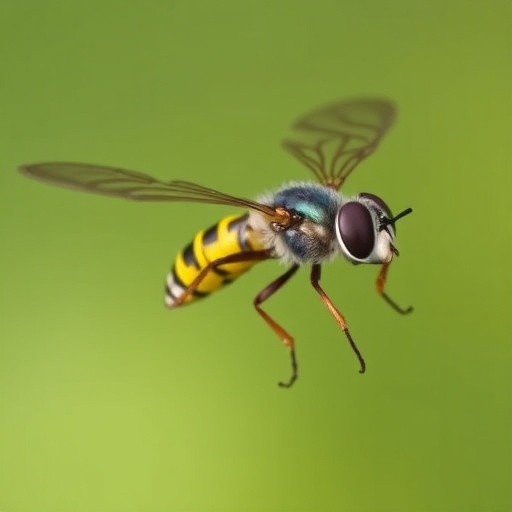In a groundbreaking study published in the prestigious journal eLife, researchers have unlocked a key piece of the aerodynamic puzzle that allows the smallest hoverfly species to defy the laws of physics and maintain flight. Contrary to long-held assumptions that smaller insects rely on faster wingbeats to generate sufficient lift, this comprehensive analysis reveals that it is, in fact, the morphological adaptations in their wings—not an accelerated flapping frequency—that grant them the ability to hover with remarkable stability.
The investigation scrutinized the interplay between wing design and wingbeat kinematics across 28 species of hoverflies with body masses ranging impressively from a mere 3 milligrams up to 132 milligrams. Within this diverse range, eight species were further studied to meticulously quantify their wing motions via advanced stereoscopic high-speed camerawork, capturing intricate three-dimensional kinematics that include flapping frequency, wing stroke amplitude, and angle of attack. Surprisingly, these measured flight dynamics showed no substantive correlation with body size, challenging the paradigm that smaller fliers compensate for aerodynamic challenges by increasing wingbeat rates or stroke amplitudes.
Instead, the key to their aerial prowess resides in the geometric and structural intricacies of their wings. Detailed morphometric analysis revealed that smaller hoverfly species possess wings with disproportionately longer spans and significantly altered surface area distributions. A vital parameter known as the second moment of area (S2), which quantifies how wing area is spaced relative to the wing hinge and directly impacts aerodynamic leverage, was notably higher in these diminutive fliers. This optimized wing morphology effectively enhances the moment arm, enabling greater lift production without necessitating changes in wingbeat mechanics.
This distinction underscores a fundamental evolutionary strategy: while the vertical force generation pattern—characterized by a small lift peak followed by a more prominent peak during each half-stroke—remains conserved across hoverfly sizes, the morphological tuning of the wing itself adjusts the vehicle’s aerodynamic performance. These insights illuminate how evolutionary pressures drive morphological diversity in insect wings to meet the stringent demands of powered flight at miniature scales, providing a fresh perspective on insect biomechanics.
To validate the functional consequences of these morphological variations, the team harnessed computational fluid dynamics simulations that combined the average wingbeat pattern observed in the studied species with their respective wing geometries. These sophisticated models accurately replicated interspecies differences in lift production, affirming that wing shape alone largely accounts for the variations in weight support, separate from wingbeat kinematics. This critical finding decisively shifts the focus from dynamic wing movements to structural adaptation when considering the mechanics of flight in small insects.
Yet, the study does acknowledge its limitations, specifically the absence of integrated data on muscular physiology and the dynamic coupling between wingbeat motion and muscle force generation. Senior author Professor Florian Muijres highlights that future interdisciplinary work incorporating muscle biomechanics alongside aerodynamic modelling will be essential to fully understand the propulsion system powering hoverfly flight. Such investigations could reveal additional constraints or capabilities embedded in the neuromuscular apparatus of these captivating creatures.
The implications of this work extend far beyond entomology, offering inspiration for bioinspired engineering and the development of micro aerial vehicles. By mimicking the natural morphological strategies of small hoverflies—optimizing wing shape to maximize leverage and lift—engineers could design more efficient flapping-wing drones capable of stable, low-energy hovering without demanding rapid wing motions or complex control mechanisms. This insight bridges evolutionary biology and applied physics, showcasing how nature’s solutions can inform next-generation technologies.
Moreover, the study enriches our understanding of the physics of flight at small scales, where viscous forces and Reynolds number effects impose unique aerodynamic challenges. Unlike larger fliers that can rely on aerodynamic inertia and more straightforward scaling relationships, small hoverflies operate in a regime where subtle shifts in wing design have pronounced effects on flight performance. The evolutionary tuning documented here highlights the delicate balance of morphological, mechanical, and physical constraints that shape the aerial capabilities of the insect world’s tiniest aviators.
This research dismantles a prevailing assumption that smaller insects simply “work harder” by flapping faster—a notion that fails to account for the biomechanical and energetic efficiency dictated by evolutionary pressures. Instead, hoverflies demonstrate a remarkable optimization strategy: maintaining a consistent wingbeat pattern while structurally modifying their wings to amplify lift. Such an approach minimizes energetic costs and mechanical strain, ensuring sustained flight capability crucial for essential behaviors like nectar feeding and mate guarding.
Camille Le Roy, lead author and postdoctoral researcher, emphasizes that this discovery reframes how scientists should conceptualize miniaturized flight, suggesting that morphological innovation rather than behavioral or kinematic change is the primary evolutionary lever. This principle could also inform studies in other insect taxa, potentially revealing convergent evolutionary pathways across diverse flying species confronting similar aerodynamic constraints.
In sum, the elegant combination of morphometric analyses, high-resolution kinematic measurements, and aerodynamic simulations delivered by this study adds a substantial chapter to our understanding of insect flight. It highlights how small hoverflies have harnessed the power of wing design—specifically elongation and surface distribution shifts—to overcome the physical barriers imposed by scaling laws, accomplishing stable and efficient flight through structural ingenuity.
As the quest continues to unravel the complete mechanics of flight, this work stands as a testament to the value of multidisciplinary approaches that meld biology, physics, and computational modeling. It invites a reexamination of long-standing assumptions about how animals at the lower bounds of size evolve to master one of nature’s most demanding and dynamic forms of locomotion: powered flight.
Subject of Research: Evolutionary and biomechanical adaptations in hoverfly wing morphology enabling flight at small scales.
Article Title: Adaptations in wing morphology rather than wingbeat kinematics enable flight in small hoverfly species
News Publication Date: 30-Sep-2025
Web References:
Journal eLife: https://elifesciences.org/
Article DOI: http://dx.doi.org/10.7554/eLife.97839.4
Keywords: Evolutionary biology, Biophysics, Insect flight, Insect wings, Morphology, Kinematics
Tags: aerodynamic stability in insectsbiology of small flying insectsevolutionary adaptations in hoverflieshigh-speed wingbeat analysishoverfly species flight dynamicshoverfly wing adaptationsinnovative research on insect aerodynamicskinematics of insect flightmorphological features of hoverfliessmall insect flight mechanicswing design and flight performancewing morphology and lift generation





